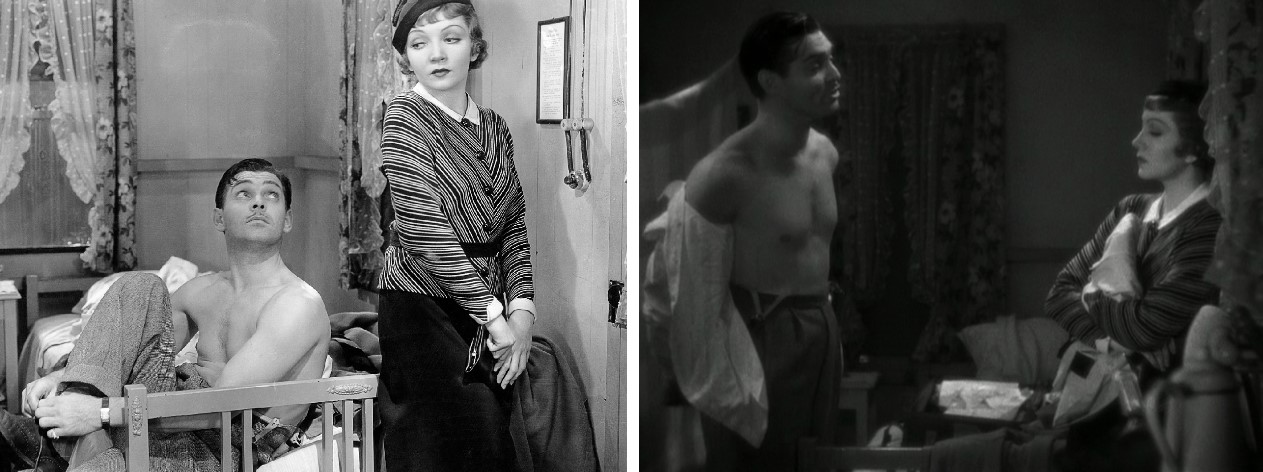10 Random Facts About Classic Hollywood
The Golden Age of Hollywood was all about the glitz and glamour. Movie stars were fashion icons, western heroes, brooding outsiders, average Joes, and femme fatales. Some had careers that spanned decades, others were short-lived in their success, and most of them were no strangers to scandal. In such crazy times as these, there are bound to exist some wild facts about the stars and films that made Old Hollywood legendary. I've rounded up 10 of them. In all honesty, they're not really «wild» facts; they're more like random, useless tidbits.
1. When Clark Gable appeared without an undershirt in It Happened One Night (1934), women across the nation stopped buying the garment for their husbands. This caused a depression in undershirts in the United States in the 1930s. In 1957, Gable said,
«I didn't know what I was doing to the undershirt people. That was just the way I lived. I hadn't worn an undershirt since I'd started school. They made me feel hemmed in and smothered.»

2. Douglas Fairbanks Jr. was made an honorary Knight Commander of the Most Excellent Order of the British Empire in 1949. Since he was not a citizen of the United Kingdom or any of the
Commonwealth realms, he could not be styled as Sir Douglas Fairbanks.

3. While filming on location in the Belgian Congo for The African Queen (1951), everyone on the set got dysentery from drinking contaminated water. The only people that escaped illness were Humphrey Bogart and director John Huston. According to Bogart,
«all we ate was baked beans, canned asparagus and drank Scotch Whiskey. Whenever a fly bit me or Huston, it dropped dead.»

«Mr. Hitler was big on me. He kept writing and inviting me to come to Germany, and if the war hadn't started when it did, I would have gone and I would have taken a gun out of my purse and shot him, because I'm the only person who would not have been searched.»

5. Lon Chaney was not only one of the most powerful and versatile actors in cinema history, but he was also a master of makeup. Chaney often played grotesque characters, and he did his own makeup for the roles. He is recognized as a groundbreaking makeup artist, and he even wrote the entry for «makeup» in the 1929 edition of the Encyclopedia Britannica.

6. To film the burning of Atlanta scene in Gone with the Wind (1939), MGM actually burned many old sets that needed to be cleared from the studio back lot, including ones from King Kong (1933) and The Garden of Allah (1936). The resulting fire was so intense that Culver City residents jammed the telephone lines, thinking that MGM was truly burning down.

7. Ronald Reagan and Jane Wyman were active FBI informants in Hollywood, reporting on other actors who they suspected of subversive activities. According to an FBI report, the Reagans provided the Bureau with «information regarding the activities of some members of the [Screen Actors] Guild who they suspected were carrying on Communist Party work.» This may have directly or indirectly contributed to the blacklisting of a large number of Hollywood employees during the HUAC hearings in 1947.
9. Charlie Chaplin and Stan Laurel shared a room in a boarding house in New York, when they went on a tour of the U.S. in 1910, as part of Fred Karno's comedy troupe. Laurel recalled,
«We had a lot of fun in those days. Charlie and I roomed together and I can still see him play the violin or cello to cover the noise of the cooking of bacon I was doing on the gas ring (forbidden of course). Then we'd both take towels and try to blow the smoke out of the window.»

10. Jean Harlow was the godmother of Millicent Siegel, daughter of the notorious mobster Benjamin «Bugsy» Siegel. Harlow was one of the first stars Siegel met when he moved to Hollywood
in the early 1930s. Soon enough, she became Millicent's godmother. Not
officially, since the role had no formal place in Jewish families. Millicent explained,
«It wasn't a formal ceremony. She just decided she was going to be my godmother, so that's what she became.»
______________________________________
SOURCES:
Benjamin «Bugsy» Siegel: The Gangster, the Flamingo, and the Making of Modern Las Vegas by Larry D. Gragg (Praeger, 2015)
Clark Gable: Biography, Filmography, Bibliography by Chrystopher J. Spicer (McFarland & Company, Inc., 2002)
Errol Flynn: Gentleman Hellraiser by David Bret (JR Books, 2009)
Stan and Ollie: The Roots of Comedy: The Double Life of Laurel and Hardy by Simon Louvish (St. Martin's Griffin, 2005)
The Art of American Screen Acting, 1912-1960 by Dan Callahan (McFarland & Company, Inc., 2018)
The Politics of Glamour: Ideology and Democracy in the Screen Actors Guild by David F. Prindle (The University of Wisconsin Press, 2012)







Comments
Post a Comment